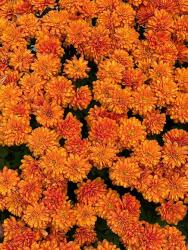Fall officially starts on September 22nd making this month the perfect time to start prepping your planters for fall. Start rotating your summer plants out for fall a few weeks before the first cold snap of the year—the end of September is a great time to start!
Out with the Old
Once you’ve decided you’re ready to prepare your planters for fall, the first step is cycling out your summer foliage. To start, it’s best to remove any leftover summer plants that won’t survive to the next season. This includes any annuals that won’t survive the first cold snap of the year. If you have any tropical plants that you’d like to save for next year, move these plants to a climate-controlled area indoors like a greenhouse, garage or sunroom.
Once your summer plants have been removed or relocated, dig out any root systems that remain in the soil. This helps loosen the soil to create room for new plants. These leftover roots can then be added to compost! The best time to begin this process is six to eight weeks before your first estimated frost, this ensures you have ample time to prep your garden.
Tip: Signs that annuals are ready to be removed include fading blooms, reduced flowers, yellowing leaves, wilting and insect damage.
Ahead of the Game
The beginning of fall is a transitional season, making it a great time to plant shrubs and evergreens. While October is the preferred month to plant evergreens, you can get a head start by selecting your plants and beginning the process towards the end of September. The milder temperatures seen this time of year allow the plants to establish their roots before the cold winter weather hits. Shrubs and evergreens that do well in planters include boxwoods, holly, conifer and juniper.
Texture Talk
If texture is what you’re looking for, combining different plant textures is an eye-catching addition that adds texture. Plants like purple kale, mexican orange blossom and mums add texture and color to typical green arrangements. It’s important to keep in mind which accent plants will be able to take a slight frost once the weather cools down.
Elevating with Accessories
Dried flowers are another low fuss way to incorporate interesting elements into fall planters. Something that is important to note is that dried flowers don’t react well to constant moisture. This makes them more suited to short-term planters or flower arrangements for a holiday event or gathering. They’re a great addition for after you’ve watered your plants and want to add a temporary touch of detail.
Pumpkin Patch
Although they’re not entirely in season yet, a spare pumpkin or gourd can add the perfect fall touch. If you’re not patient enough to wait for them to arrive at your local grocery store, try adding fake pumpkins or gourds for early decorations. Once it’s time for the real deal, you can relocate the fake foliage indoors for extra fall inspiration!









